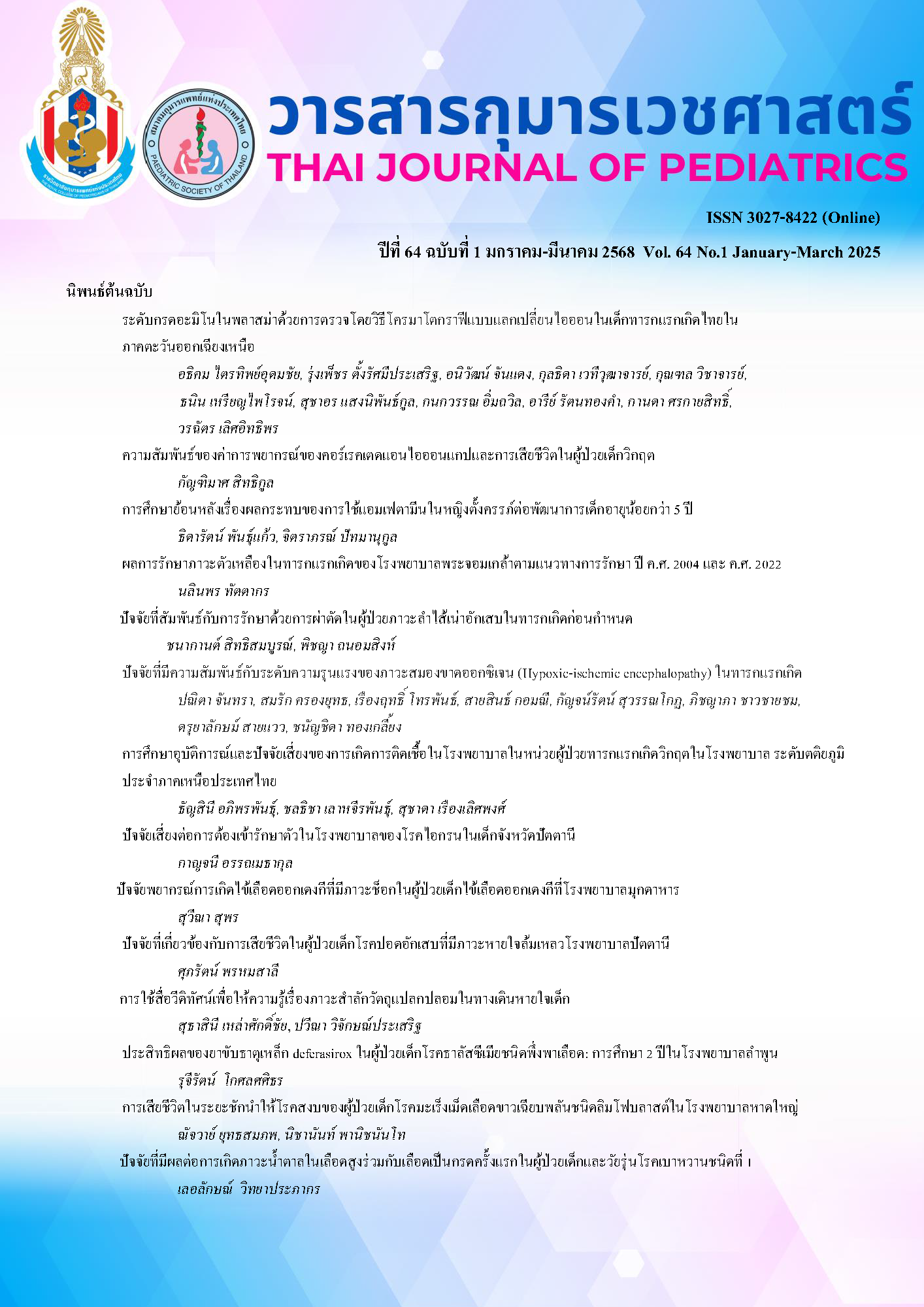Prognostic factors associated with dengue shock syndrome in dengue hemorrhagic fever in pediatric patients, Mukdahan Hospital
Keywords:
dengue hemorrhagic fever, dengue shock syndrome, prognostic factorAbstract
Background: Dengue hemorrhagic fever (DHF) is an important disease, including diagnosis and treatment. Knowing the prognostic factors associated with dengue shock syndrome (DSS) in dengue hemorrhagic fever in pediatric patients will help in monitoring and treatment more effectively.
Objective: To determine clinical characteristics and the prognostic factors associated with dengue shock syndrome in dengue hemorrhagic fever in pediatric patients.
Method: A retrospective observational study using a prognostic factor research approach was conducted in a pediatric ward, Mukdahan Hospital. Patients aged 1 month to 15 years with a diagnosis of dengue hemorrhagic fever were enrolled between 1 October 2016 to 31 May 2024. Chi-square test and multivariate logistic regression were used to identify prognostic factors associated with dengue shock syndrome.
Result: A total of 120 patients were enrolled in this study and 34 patients (28.3%) were diagnosed with dengue shock syndrome. The most common age group was 10-13 years old (46.7%). The three most common presenting symptoms were fever (100.0 %), nausea (35.0%) and vomiting (34.2%). On multivariate analysis, the significant factors associated with dengue shock syndrome were nutrition status (risk ratio [RR] 11.8, 95% CI 1.4-103.6, p value 0.03), bleeding per gum (RR 16.7, 95% CI 1.2-233.8, p value 0.04) and pleural effusion (RR 14.9, 95% CI 2.2 -101.1, p value 0.01).
Conclusion: Pediatric patients with dengue hemorrhagic fever should be closely monitored during treatment, especially those with abnormal nutrition status, bleeding per gum and pleural effusion.
Downloads
References
World health organization. Dengue guidelines for diagnosis, treatment, prevention and control [Internet].2009.[cited2024April1]..Available.from:.https://www.who.int/publications/i/item/9789241547871
วรวิทย์ กันทะมาลี, นพพร อภิวัฒนากุล, สมาคมโรคติดเชื้อในเด็กแห่งประเทศไทย. ความรู้สำหรับประชาชน โรคไข้เลือดออก (Dengue) [Internet]. 2024 [cited 2024 June 16]. Available from: https://www.pidst.or.th/A713.html
ยุวดี คงนก. เปรียบเทียบลักษณะทางคลินิกของไข้เดงกีและไข้เลือดออกเดงกีในผู้ป่วยเด็กที่มารับการรักษาในโรงพยาบาลพัทลุง. วารสารวิชาการแพทย์เขต 11 2559;30:139-47.
Hussain w, Shaikh M, Hanif M, Ashfaq M, Ahmed H, Nisa BU. Pattern and outcome of dengue fever in a pediatric tertiary hospital: A retrospective report. Cureus. 2021;13:1-6.
Pichainarong N, Mongkalangoon N, Kalayanarooj S, Chaveepojnkamjorn W. Relationship between body size and severity dengue hemorrhagic fever among children aged 0-14 years. Southeast Asian J Trop MedPublic Health. 2006;37:283-8.
World health organization. Dengue and severe dengue [Internet]. 2023 [cited 2024 March 23]. Available from: https://www.who.int/news-room/fact-sheets/detail/dengue-and-severe-dengue
ราชวิทยาลัยกุมารแพทย์แห่งประเทศไทย. คำแนะนำแนวทางเวชปฏิบัติการวินิจฉัยและการรักษาโรคไข้เลือดออกเด็กกี่ในเด็กและวัยรุ่น 15 มกราคม 2567 ฉบับก่อนประชาพิจารณ์ [Internet]. 2024 [cited2024.June.16]..Available.from:.https://drive.google.com/file/d/1TyT4B7Oj3kSlqPVSL1TfpKUA2ZhSA_kx/view
สถาบันป้องกันควบคุมโรคเขตเมือง กรมควบคุมโรค กระทรวงสาธารณสุข. สรุปรายงานเหตุการณ์ที่สำคัญทางระบาดวิทยา [Internet]. 2023 [cited 2024 March 24]. Available from: https://ddc.moph.go.th/uploads/publish/1517920240108030356.pdf
Maneerattanasak S, Suwanbamrung C. Impact of nutritional status on the severity of dengue infection among pediatric patients in southern Thailand. Pediatr Infect Dis J 2020;39: 410-6.
Baiduri S, Husada D, Puspitasari D, Kartina L, Basuki PS, Ismoedijanto. Prognostic factors of severe dengue infections in children. IJTID. 2020;8:43-53.
Sangkaew S, Ming D, Boonyasiri A, Honeyford K, Kalayanarooj S, Yacoub S, et al. Risk predictors of progression to severe disease during the febrile phase of dengue: A systematic review and meta-analysis. Lancet Infect Dis 2021;21:1014-26.
Ningrum EFS. Prognosis factors for dengue shock syndrome in children. J Clin Intensive Care Med2021;6:033-7.
ศิริเพ็ญ กัลยาณรุจ, มุกดา หวังวีรวงค์, วารุณี วัชรเสวี. แนวทางการวินิจฉัยและรักษาโรคไข้เลือดออกเดงกี ฉบับเฉลิมพระเกียรติ 80 พรรษามหาราชินี. กรุงเทพมหานคร: โรงพิมพ์องค์การสงเคราะห์ทหารผ่านศึก; 2556.
ทรงพล พงศ์พัฒนโชติ. การศึกษาและทบทวนโรคไข้เดงกี่และไข้เลือดออกเดงกี่ 5 ปี ย้อนหลัง
หอผู้ป่วยกุมารเวชกรรม โรงพยาบาลยโสธร. สรรพสิทธิเวชสาร 2565;43:61-71.
Sudjaritruk T, Oberdorfer P, Clinical characteristics and outcomes of dengue-infected children admitted to the Chiang Mai University Hospital during an outbreak in 2008. Chiang Mai Med J 2011;50:95-104.
Idrus NL, Jamal SM, Bakar AA, Embong H, Ahmad NS. Comparison of clinical and laboratory characteristics between severe and non-severe dengue in paediatrics. PLOS Negl Trop Dis 2023;17:1-10.
กันตภณ ตรงกมลชัย, สุภโชค ตรงกมลชัย. การเปลี่ยนแปลงทางระบาดวิทยาของผู้ป่วยเดงกีในโรงพยาบาลดำเนินสะดวก จังหวัดราชบุรี.วารสารกุมารเวชศาสตร์ 2561;57:183-7.
Sirivichayakul C, Limkittikul K, Chanthavanich P, Jiwariyavej V, Chokejindachai W, Pengsaa K, et al. Dengue infection in children in Ratchaburi, Thailand: A cohort study. II. Clinical Manifestations. PLOS Negl Trop Dis. 2012;6:1-10.
Sreenivasan P, Geetha S, Sasikala K. Development of a prognostic prediction model to determine severe dengue in children. Indian J Pediatr. 2018;85:433-9.
Downloads
Published
How to Cite
Issue
Section
License
Copyright (c) 2025 The Royal College of Pediatricians Of Thailand

This work is licensed under a Creative Commons Attribution-NonCommercial-NoDerivatives 4.0 International License.


